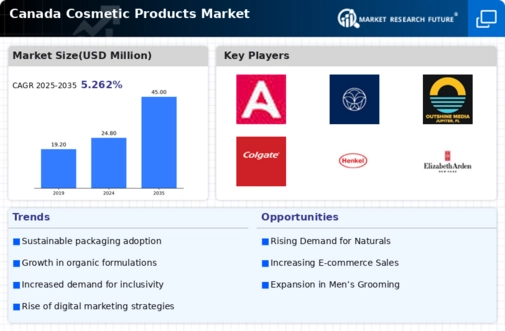Rise of Male Grooming Products
The cosmetic products market in Canada is witnessing a significant rise in male grooming products. Traditionally dominated by female consumers, the market is now expanding to include a diverse range of products specifically designed for men. This shift is attributed to changing societal norms and an increasing acceptance of grooming among men. Recent statistics indicate that the male grooming segment is projected to grow at a CAGR of 5% over the next five years. Brands are responding by launching targeted marketing campaigns and product lines that cater to male consumers, thereby diversifying their offerings within the cosmetic products market.
Growing Demand for Natural Ingredients
The cosmetic products market in Canada is experiencing a notable shift towards natural and organic ingredients. Consumers are increasingly seeking products that are free from harmful chemicals and synthetic additives. This trend is driven by heightened awareness of health and environmental issues, leading to a preference for brands that prioritize sustainability. According to recent data, approximately 60% of Canadian consumers express a willingness to pay a premium for cosmetics made with natural ingredients. This growing demand is prompting manufacturers to reformulate existing products and innovate new offerings that align with consumer preferences, thereby reshaping the landscape of the cosmetic products market.
Sustainability and Ethical Consumerism
Sustainability is becoming a pivotal driver in the cosmetic products market in Canada. Consumers are increasingly prioritizing brands that demonstrate a commitment to ethical practices, including cruelty-free testing and eco-friendly packaging. This shift is reflected in the growing number of certifications and labels that emphasize sustainability. Recent surveys indicate that over 50% of Canadian consumers are willing to switch brands for more sustainable options. Consequently, companies are adapting their business models to align with these values, leading to a more responsible and transparent cosmetic products market.
Influence of Social Media on Consumer Choices
Social media platforms are profoundly influencing consumer behavior within the cosmetic products market in Canada. The rise of beauty influencers and content creators has transformed how consumers discover and engage with brands. Approximately 70% of Canadian consumers report that social media significantly impacts their purchasing decisions. This trend has prompted brands to invest heavily in digital marketing strategies, leveraging platforms like Instagram and TikTok to reach their target audiences. As a result, the cosmetic products market is increasingly characterized by dynamic interactions between brands and consumers, fostering a community-driven approach to beauty.
Technological Advancements in Product Development
Technological innovation plays a crucial role in the evolution of the cosmetic products market in Canada. Advances in formulation science, such as the use of biotechnology and nanotechnology, enable the creation of more effective and safer products. For instance, the incorporation of smart technology in skincare products allows for personalized solutions tailored to individual skin types and concerns. This trend is likely to enhance consumer engagement and satisfaction, as products become more targeted and effective. Furthermore, the integration of augmented reality in retail settings is transforming the shopping experience, allowing consumers to virtually try on products before purchase, thus driving sales in the cosmetic products market.






















Leave a Comment